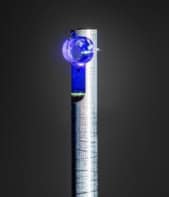An article in the Sunday Times of London entitled "Big Bang machine could destroy Earth" has not gone down well at the Brookhaven National Laboratory in the US. The story describes how strange particles produced at Brookhaven's Relativistic Heavy Ion Collider (RHIC) "might start an uncontrollable chain reaction that could convert anything they touched into more strange matter". Brookhaven has responded with a press release which states that "there is no chance that any phenomenon produced by RHIC will lead to disaster."
The RHIC seeks to recreate the primordial “soup” of particles that existed immediately after the big bang and from which everyday matter formed. Today quarks only exist inside strongly interacting particles, called hadrons, where they are held together by gluons. By colliding two beams of relativistic heavy ions – such as gold ions travelling near the speed of light – the physicists using RHIC hope to create matter with an energy density so high that the quarks and gluons will co-exist as a plasma
The present controversy started with a letter in the July issue of Scientific American that asked if the collisions at RHIC could produce mini-black holes. This was followed up by the Sunday Times on 18 July. The newspaper reported that RHIC might produce mini-black holes and strange matter, and that Brookhaven had “set up a committee of physicists to investigate whether the project could go disastrously wrong.” An accompanying editorial accused scientists of acting first and asking questions “later.”
Since then Brookhaven has been besieged by the media and the public. “We’ve had emails, telephone calls and letters from all over the world including India, Pakistan, Australia and Europe,” said a Brookhaven spokesperson. On 19 July Brookhaven director John Marburger responded with a press release: “These issues have been raised and examined by responsible scientists who have concluded that there is no chance that any phenomenon produced by RHIC will lead to disaster.”
Jonathan Leake, who wrote the Sunday Times story, believes that Brookhaven only has itself to blame for the outcry. He also points out that the article quotes physicists as saying that the risk is small. “Brookhaven mishandled their response to the fears on this issue,” he told PhysicsWeb.



